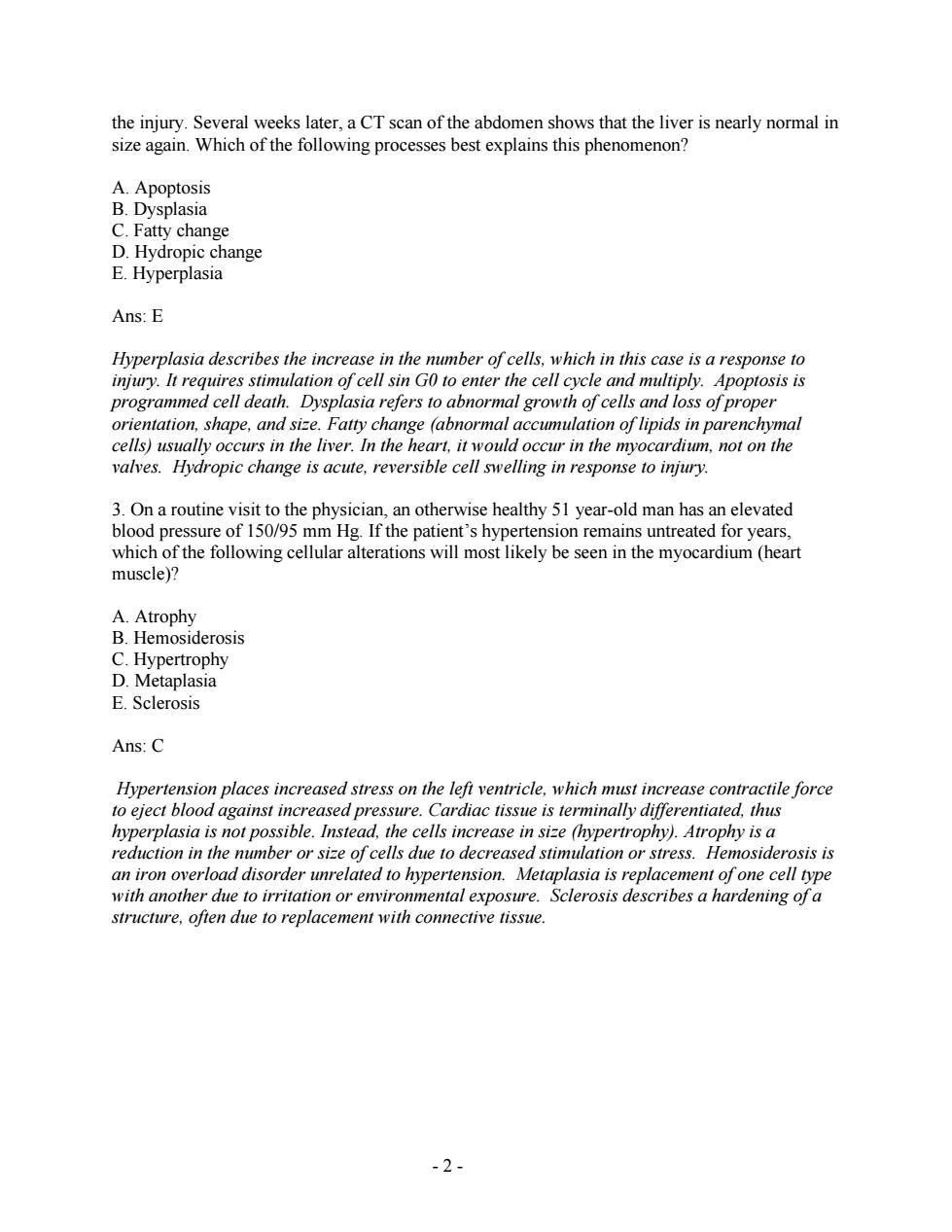正在加载图片...

the injury.Several weeks later,a CT scan of the abdomen shows that the liver is nearly normal in size again.Which of the following processes best explains this phenomenon? A.Apoptosis B.Dysplasia C.Fatty change D.Hydropic change E.Hyperplasia Ans:E in the mber of cells.which in this case is ar enter l grow py.Apoptosis is shape,and size.Fatty change (abnormal accumulation of lipids in parenchyma cells)usually occurs in the liver.In the heart,it would occur in the myocardium,not on the valves.Hydropic change is acute.reversible cell swelling in response to injury. 3.On a routine visit to the physician,an otherwise healthy 51 year-old man has an elevated blood pressure of 150/95 mm Hg.If the patient's hypertension remains untreated for years, which of the following cellular alterations will most likely be seen in the myocardium(heart muscle)? A.Atrophy B.Hemosiderosis C.Hypertrophy D.Metaplasia E Sclerosis Ans:C places increased stress on the lejt ventricle.which msi increase contractlejorce a pres. not possible. Instea cells in number or size of cells due to decreased stimulation or stress. an iron overload disorder unrelated to hypertension.Metaplasia is replacement ofone cell type with another due to irritation or environmental exposure.Sclerosis describes a hardening ofa structure,often due to replacement with connective tissue. -2- 2 - the injury. Several weeks later, a CT scan of the abdomen shows that the liver is nearly normal in size again. Which of the following processes best explains this phenomenon? A. Apoptosis B. Dysplasia C. Fatty change D. Hydropic change E. Hyperplasia Ans: E Hyperplasia describes the increase in the number of cells, which in this case is a response to injury. It requires stimulation of cell sin G0 to enter the cell cycle and multiply. Apoptosis is programmed cell death. Dysplasia refers to abnormal growth of cells and loss of proper orientation, shape, and size. Fatty change (abnormal accumulation of lipids in parenchymal cells) usually occurs in the liver. In the heart, it would occur in the myocardium, not on the valves. Hydropic change is acute, reversible cell swelling in response to injury. 3. On a routine visit to the physician, an otherwise healthy 51 year-old man has an elevated blood pressure of 150/95 mm Hg. If the patient’s hypertension remains untreated for years, which of the following cellular alterations will most likely be seen in the myocardium (heart muscle)? A. Atrophy B. Hemosiderosis C. Hypertrophy D. Metaplasia E. Sclerosis Ans: C Hypertension places increased stress on the left ventricle, which must increase contractile force to eject blood against increased pressure. Cardiac tissue is terminally differentiated, thus hyperplasia is not possible. Instead, the cells increase in size (hypertrophy). Atrophy is a reduction in the number or size of cells due to decreased stimulation or stress. Hemosiderosis is an iron overload disorder unrelated to hypertension. Metaplasia is replacement of one cell type with another due to irritation or environmental exposure. Sclerosis describes a hardening of a structure, often due to replacement with connective tissue